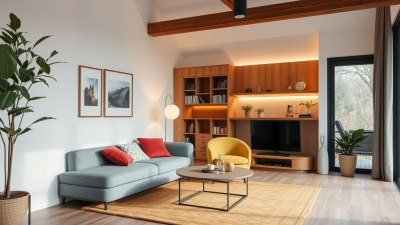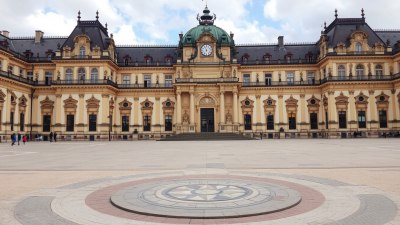Making Home a Moving Place
Explore innovative ideas to transform your living space into a dynamic and evolving home that suits your lifestyle.

Image created with Flux Schnell
In an ever-changing world, the concept of home is evolving too. It’s no longer just a static place where we reside; it's becoming a dynamic hub that reflects our lifestyles and preferences. The phrase 'making home a moving place' encapsulates the spirit of adaptability and transformation that many seek today. Whether through smart design, technology integration, or flexible living arrangements, there are numerous ways to turn a traditional dwelling into a lively space that adapts to our needs. In this article, we will explore various strategies to help you create a home that embodies the principles of movement, flexibility, and personalization.
1. Embracing Minimalism
The minimalist trend has taken the interior design world by storm, and for good reason. By reducing clutter and focusing on functionality, you can create a space that feels open and versatile. A minimalist approach encourages you to curate your belongings, allowing only essential items that serve a purpose. This not only makes your home more visually appealing but also provides a blank canvas for change, making it easier to adapt your space as your life evolves. Remember, a moving home doesn’t mean constant change; it sometimes means having the freedom to rearrange and refocus your living environment.
2. Modular Furnishings
Investing in modular furniture is a game-changer for those looking to make their home a moving place. These versatile pieces can be reconfigured to suit various activities and gatherings. For example, modular sofas can be rearranged for seating during a movie night or broken down to create more space for a party. Additionally, modular shelving units allow for personalization and can be adjusted to accommodate your changing storage needs. The key is to choose furnishings that offer flexibility and utility, enabling you to adapt your space effortlessly as life demands.
3. Smart Home Technology
Incorporating smart home technology is another powerful way to make your home feel dynamic. Smart thermostats, lighting systems, and appliances can be programmed to cater to your daily routines. For instance, you can set your lights to adjust based on the time of day or your activity level. Voice-controlled devices enable quick changes in your home environment—whether it’s playing music, adjusting the temperature, or turning off appliances. This connectivity not only enhances convenience but also supports a more responsive living space that can adapt to your lifestyle.
4. Flexible Spaces
To create a moving place, consider integrating flexible spaces into your home design. Rooms should serve multiple purposes, allowing you to transform areas as needed. For example, a spare bedroom could double as an office or a gym, utilizing wall beds or foldable furniture for maximum efficiency. Open floor plans that allow for easy reconfiguration are ideal for promoting flexibility. Create areas that are multifunctional and easily adaptable, so each room can transform to meet your requirements at any given moment.
5. Indoor-Outdoor Harmony
Bringing the outside in and the inside out creates a vibrant living environment that feels alive. Large windows, sliding doors, and outdoor patios can help blur the lines between indoor and outdoor spaces. Consider incorporating biophilic elements like houseplants, natural light, and outdoor views to enhance your home’s dynamism. This connection with nature not only fosters a sense of tranquility but energizes your living space, making it feel more inviting and harmonious.
6. Personal Touches
Injecting your personality into your home makes it a unique reflection of who you are. Personal touches through artwork, photographs, or handmade decor items reveal your journey and interests. Changing out these elements occasionally can keep your space fresh and moving, reflecting your evolving tastes and experiences. Consider creating a gallery wall that you can update over time or introducing seasonal decorations that add a sense of warmth and liveliness to your home.
7. Sustainable Choices
Sustainability is an essential factor to consider when making your home a moving place. This not only pertains to the materials you choose but also how you approach energy consumption. Opt for eco-friendly materials such as reclaimed wood, recycled glass, or bamboo. Additionally, incorporating energy-efficient appliances and renewable energy sources—like solar panels—can significantly impact your home’s adaptability and efficiency. Embracing sustainable practices also contributes to creating a healthier environment, both for you and the planet.
8. Dynamic Color Schemes
Colors have the power to evoke feelings and set the mood of a space. By using dynamic color schemes, you can change the atmosphere of your home with ease. Consider painting an accent wall that reflects seasonal changes or using removable wallpaper that allows you to switch up your style without committing to permanent changes. Textiles—such as curtains, pillows, and throws—offer another avenue for spontaneity and adaptability, enabling you to introduce new colors and patterns that rejuvenate your space.
9. The Power of Layout
The layout of a room dramatically influences its utility and feel. Implementing flexible layouts allows for a space to transform according to your needs. Experiment with various arrangements and embrace the flow of traffic in and out of rooms. Furniture placement can create cozy nooks for reading or open areas for socializing. The right layout facilitates movement and encourages a dynamic environment that adjusts as your lifestyle changes.
10. Future-Proofing Your Home
As you make your home a moving place, consider future-proofing aspects of your design. Trends come and go, so focusing on timeless design elements will keep your home relevant and adaptable. Choose classic finishes that withstand the test of time, ensuring that your living space remains functional as your needs evolve. Additionally, building for flexibility—from structurally sound walls that can accommodate new layouts to electrical wiring that supports modern technology—will keep your home at the forefront of innovation.
Making your home a moving place is about embracing flexibility, personalization, and innovation. By understanding how to harness various design principles and integrate technology, you can cultivate an environment that breathes life into your living space. Whether you choose minimalism, modular furniture, or artful color schemes, the aim is to create a home that not only reflects who you are but also adapts and grows as your needs and lifestyle change. Transform your living area into a dynamic sanctuary that feels alive and responsive, dedicated to your ever-evolving journey.











